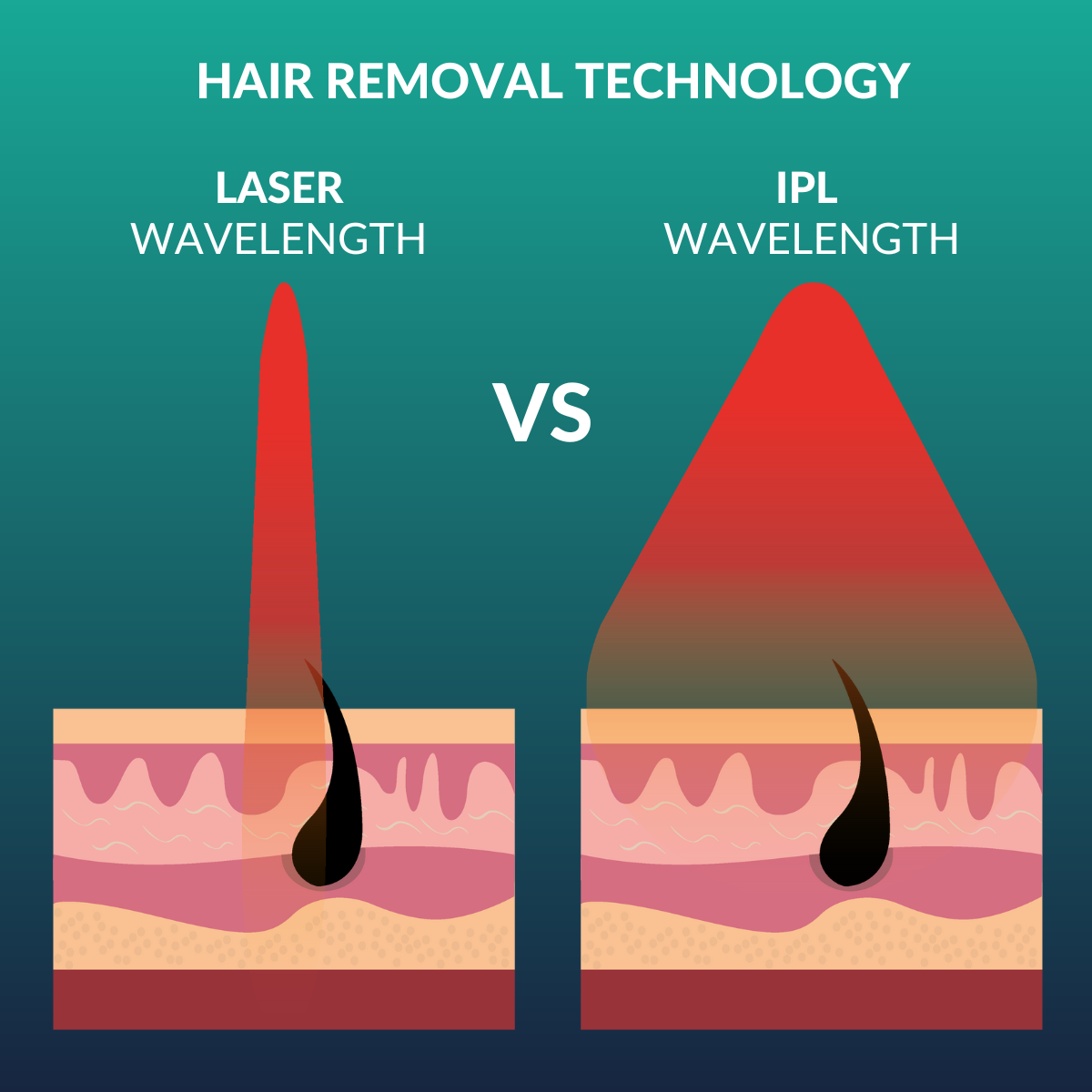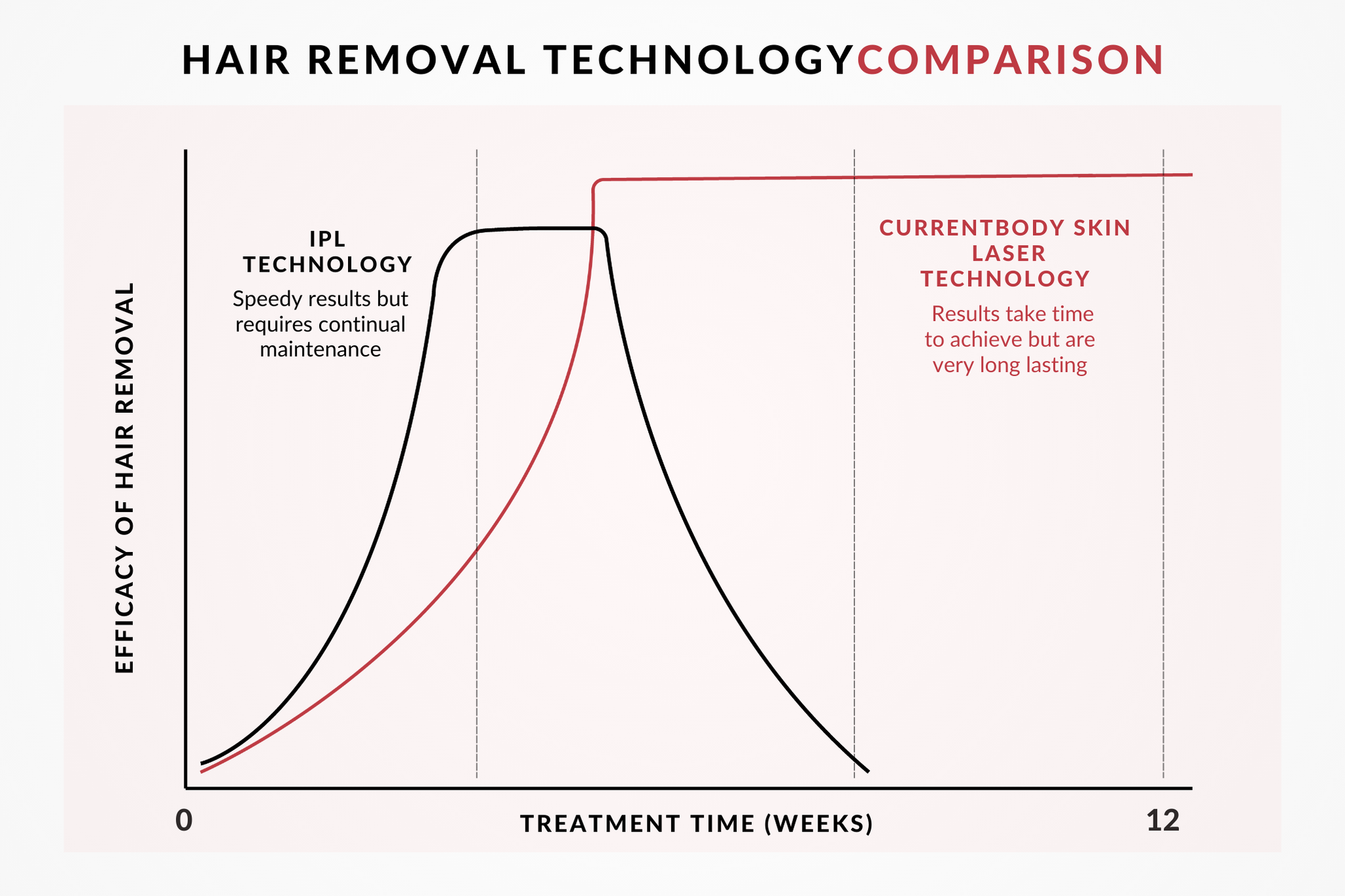• 26 February 2024
Unwanted hair can be a buzzkill. Whether you’re a woman wanting smoother legs, underarms and bikini line or a man looking to tidy up your back, chest or body hair. Choose between laser hair removal or IPL (intense pulsed light) technologies to achieve a permanent hair removal solution that works for you.
What’s the difference between IPL vs laser hair removal? With the average woman spending around £23,000 on hair removal in her lifetime, it’s high-time we got some answers about the best hair removal treatment for you.

What is laser hair removal and how does it work?
Laser hair removal generates a single beam of a powerful, concentrated light wavelength to absorb melanin within the hair follicle. Over multiple treatment sessions, this laser energy generates heat—which progressively weakens and permanently disables the hair follicle, resulting in long-term hair reduction.
How does IPL (intense pulsed light) hair removal work?
Just like laser hair removal, IPL also targets melanin to destroy hair follicles. However, unlike laser treatments that use a single wavelength, IPL utilises multiple light wavelengths to emit diffused energy, ensuring minimal to zero skin damage.
These wavelengths are delivered in continuous, consecutive pulses—resembling the effect of a camera flash. This is the technology that can be most commonly found in home use hair removal devices use for achieving long-term hair removal. While effective, IPL does not give the same lasting results that laser provides.

IPL versus laser hair removal for the face
Both IPL and laser hair removal offer various benefits for women, helping to control peach fuzz, maintain smooth skin and hormonal hair growth. For men, these technologies offer solutions to reducing ingrown hairs from shaving.
Laser is effective for black or dark brown hair, along with a broader range of skin tones with contrasting hair colours. IPL works best for light to medium skin types with dark hair, as well as targeting light brown hair. Neither method is suitable for blonde, grey, red or white hair.
Although laser devices and IPL technology both use light energy, laser hair removal machines are proven to be more powerful. Laser is also the clinic choice for professional hair removal. IPL produces a broader spectrum beam of diffused light energy, making it less effective at targeting each hair follicle with power and precision.

Is IPL more painful than laser hair removal?
No, IPL hair removal is typically less painful than professional laser treatments in-clinic because it uses lower-intensity light. However, both technologies feel the same when used in a portable, home use device engineered with advanced cooling air systems and UV sensors to minimise discomfort.
We recommend to prioritise eye protection by wearing the goggles often provided. Many at home devices use skin safety sensors, such as the SmoothSkin Pure Fit IPL Hair Removal Device. Built-in sensors optimise the amount of light waves for your skin tone. The Smart Skin Sensing Technology controls the light energy over 80 times per second, while its advanced 3mm glass UV filter reduces skin surface temperature for a comfortable, pain free experience.
While both laser and IPL may lead to temporary side effects like minor redness and minimal swelling, IPL and laser hair removal are suitable for sensitive skin types.

How long does it take for IPL and laser to remove hair permanently?
Research says it takes 4 to 6 sessions over 12 to 16 weeks to see significant results with IPL hair removal, although some devices can achieve similar results within just 4 sittings. One such device is the E-One Clinic Permanent Hair Removal, which uses a wide optic cartridge to deliver 3,000 light flashes over a larger surface area. And instead of weekly IPL sessions, you only need to use the E-One every 6 to 8 weeks to see hair free results.
Laser hair removal works even faster, showing results in 3 to 4 sessions. The CurrentBody Skin Laser Hair Removal Device is the only FDA-cleared permanent at home laser hair removal device on the market, proven to reduce hair count by 80% in just 4 weeks. One independent study found that 93% of users were left with no hair root residue after using this laser hair removal device 2 to 3 times per week for 4 weeks.

How long does IPL hair removal last?
Results from intensive twice-monthly sessions for 12 weeks typically last for 6 to 8 months, with the opportunity to extend to 1.5 years with repeated touch-ups every 3 months. Hair growth variations can influence the longevity of these results. For example, hormone-driven hair regrowth over the lip, chin, underarms, chest, back and bikini line may need more touch-ups than the hairline, arms, legs, hands and feet.
What is better, IPL or laser hair removal?
While both technologies have their advantages, laser hair removal is faster, more precise and can cater to darker skin tones while delivering permanent hair reduction. IPL and laser technology are also both available for safe, self-administered home use on the face, arms, legs, bikini line, chest and hands.
In-clinic laser sessions can cost anywhere between £500 to £1500, whereas the CurrentBody Skin Laser Hair Removal Device offers an affordable one-time purchase. IPL hair removal provides similar results to laser, and can be found in a wider range of home use devices.





